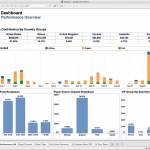Forecast Ahead: Exploring Customer Lifetime Value Factors
Changes in businesses occur as frequently as the weather. One day it may be a perfect 80 degrees with sunshine and endless possibilities, the next, a cold front moves in and it’s below 40 degrees with rain, wind and dark skies ahead.
Fortunately for any business, Customer Lifetime Value (CLV) is a steadfast method by which to navigate ebbs, flows and forecast the overall health of your business. For example, if your customers’ lifetime value is $500 and the Cost Per Acquisition (CPA) to acquire that customer is $75, then that customer is considered to be profitable ($500 CLV – $75 CPA = $425 Profit).
According to Journal of Interactive Marketing (2012), Customer Lifetime Value is “attributed to the increase in profits from loyal customers to the price premium paid by loyal customers, the
Added profits from sales through referrals, profit from cost savings obtained by serving an old customer, and revenue growth from a loyal customer due to increase in sales to that customer.” Subsequently, these factors are considered a “summary of the commonly held reasons for increases in profitability from long-lifetime customers.”
The factors significantly affect the CLV for any business, its acquisition, engagement, retention of customers and revenue. Each factor can be accurately measured using data analytics.
Increase in profit from loyal customers
Fundamentally, loyalty only has a value if a customer creates profit for a company. Non-profit generating customers do not contribute to the loyalty factor. Furthermore, a customer-centric company is able to regularly increase its number of loyal customers to develop a more sustainable revenue stream. These loyal customers have varying reasons for staying onboard and spending money at higher rates as they continue their relationship with your company.
Price premium paid by loyal customers
A survey from the Journal of Product and Brand Management (1992), determined that for premiums paid by loyal customers “quality is a significant determinant of price premium” in addition to social image, uniqueness, home country origin, corporate social responsibility (CSR) and awareness. These premiums become a normal part of doing business with your company for the loyal customers and foster in them, a sense of good-will and ownership in your organization. These feelings create the perfect climate for referrals.

Profit from sales through referrals
The power of a referral can never be underestimated when it comes to the bottom line and especially not when a loyal customer provides sales leads. The vetting that takes place through such a process, not only generates goodwill from the potential new customer to your company, it reduces the cost per acquisition that would usually be required for obtaining the new customer. In the long-term, referral customers provide a greater CLV, however customers who once did business with your company but stopped for a number of reasons, can be the pot of gold at the end of a rainbow.
Profit from cost savings obtained by serving an old customer
Obtaining new customers will always have a higher cost per acquisition than serving a current customer. Equally, when your company has developed a comprehensive database of customers through data modeling, locating and targeting former customers can be extremely beneficial. Maintaining this data and logging trends of the particular customer in the Customer Management System, empowers your team to foster new relationships and offer new solutions to meet their needs. Therefore, good data movement is imperative to move loyal customers to the next level.
Revenue increases from a loyal customer
Analysis of customer behavior, buying patterns, and frequency of purchases would reveal what segments of customers are loyal, and which segments require personalized marketing offers to grow into higher tiers of loyalty. From the analysis, you can see trends in everything from purchasing, new service onboarding and service downsizing or breaks, making this analysis vital to developing customer lifetime value campaigns such as loyalty programs and targeted sales and marketing efforts to increase sales.
Customer lifetime Value is imperative for any business, and has its influences in various units of a company. For the marketing teams, CLV informs marketing strategies around acquisition and loyalty programs. Product teams use the CLV metric to gauge the interest and engagement levels of customers, and that drives the design and presentation of the company’s products. Sales and customer service teams drive sustainable revenue while reducing customer returns and managing to expected lifetime revenue per customer.
In summary, customer analytics is an integral part of the lifetime value analysis process, and it provides the knowledge of how much a customer is worth, and how much a business should be paying to acquire a new customer, retain current customers, or re-engage old customers, all of whom have the power to fuel the bottom line through any financial climate.
Visit our homepage, subscribe to more articles and updates.








